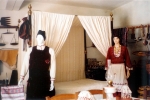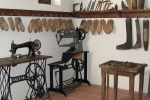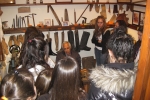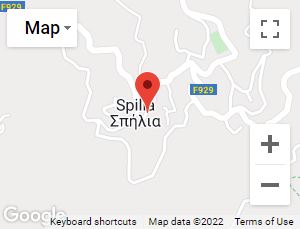Fighter’s Sacrifice Museum
It is situated at Kourdali. It is the ground floor of the house of Andreas and Eirini Patsalides. It was here that the E.O.KA fighters Andreas Patsalides, Costas Anaxagora, Alecos Constandinou and Panayiotis Georgiadis lost their lives. They were dismembered when a mine erupted in their hands while they were being trained about its use. The house was semi destroyed by the powerful blast.
At this area, the remains of this horrible accident, personal belongings of the heroes and photographs with explanatory texts, illustrate the way this humble house became the sacrifice tomb of the E.O.K.A fight.
Popular Art Museum in Spilia
The “Popular Art Museum” is situated at the entrance of the core of Spilia, upon the community’s main road. It was established in 2005 by the association “PROODOS”. The inspirer and prime mover for the creation of this museum was the Secretary of the Association, Ktoris Michael.
Displayed in this museum, are almost all the furniture and utensils of a traditional house. The bed with the attached mosquito curtain on the top and next to it two dolls representing a man and a woman dressed in traditional gowns. In the middle of the room, a food table with wooden chairs which have clothed seats, a clay wine jug and clay glasses remind you of the good old times. A straw basket in which people used to put bread in hangs over the roof, clay jugs in which pieces of meat preserved in pork fat were put, clay containers in which the traditional white cheese called ‘halloumi’ was placed and a cabinet used for storing another kind of traditional white cheese called ‘anari’, awake our childhood memories. Projected in another corner is a space formed in such a way that it would hold the traditional clay jugs that were used for carrying water and an actual clay jug, the mouth of which closes with a savory and a handkerchief on top of it so that it would provide extra protection to the water.
A speltered-made bathroom with a small tap next to it (a small semi circular tank) hanging over the wall. A broom for the bedrooms and a ‘sarka’, another kind of traditional broom used for cleaning the yard, complete the cleaning tools. A wardrobe with a traditional mirror leaned against a wall and an iron which operated with charcoal posing on a wooden kind of shelf, are some of the simple tools that were used for fig during the era of our parents.
Apart from the equipment of an old house, there is also the gear used for household occupations such as the blending and making of ‘halloumi’, the traditional white cheese of Cyprus. Also displayed are some of the means of traditional professions or occupations. The barber and the shoemaker steal the show of the professions whereas the farmer and the builder do not get passed unmarked.
Finally, an adorable donkey with its muzzle, the pack saddle tied with a rope and a cute piece of clothing which was used to put the pack saddle on, certainly attract attention.
A single page is not enough to include the description of the ‘Popular Art Museum’. It simply provides a vague picture of its rich and wisely fixed up content.

The Museum of the Shoemaker Christos Chrysanthou in Spilia
The “Museum of the shoemaker Christos Chrysanthou” in Spilia was created by Andreas Christos Chrysanthou in the memory of his father. The inauguration ceremony took place in a community event on the 20th October 2007 by the Minister of Interior Mr. Christos Patsalides. It is accommodated in the semi underground floor of the first listed residence of Spilia, which belongs to Andreas Chrysanthou. The residence is located in the centre of the community.
Displayed in the Museum are the tools of the shoemaker’s craft and the machines of Christos, who was known for his skills in the surrounding villages. The forming patterns called ‘moles’, the leathers and the note books with the credit, in addition to the photographs of high-profiled people which adorned his store, complete his shoemaker’s store.
The humble bench of Christos the shoemaker, which was made in 1920, and the tools that were so extensively used, cause a shivery emotion. The thirty pairs of shoe trees separated for children’s, women’s and men’s shoes, the shoe trees for the men’s boots and the women’s buskins, fixed up in order, make a particular impression.
Situated in a corner is the family table manufactured in 1926. On top of it is the wine, the ‘zivania’ and the vegetables of Chief Christos. Right above it are four photographs depicting the area’s best dancer while dancing in community events, which are of particular interest.
Presented right next to it, is the gear of the hunter Christos. A 1936 gun with the traditional back-pack called ‘vourka’, his belt and his canteen, an iron basket with its trap nets and a rabbit trap, comprise a fine set. These are the three ways he used in order to hunt during his entire life.
Displayed high, above a traditional wooden shelf called ‘souvantza’, are some of the tools of the farmer Christos. What is of particular interest is his pruning hook which has his name engraved on.





